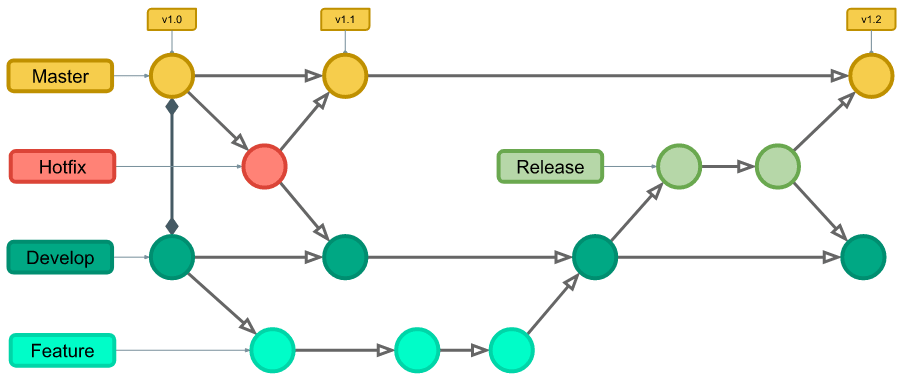Git & Gitflow Cheetsheet ES
GIT
Comandos de Git basicos o frecuentes
$ git init # Crear un nuevo git
$ git add # Agregar archivos al area de preparacion
$ git status # Estado del repositorio
$ git commit -m # pasar archivos del area de preparacion al repositorio local
$ git log # ver las versiones de archivos del repositorio
$ git clone # clonar un repositorio remoto
$ git push # modificar el repositorio remoto, con su nueva actualizacion
$ git pull # actualizar tu repositorio local con la ultima version del remoto
$ git add . # sirve para agregar todos los archivos modificados al area de preparacion
GIT FLOW
Instalar en linux debian
Para instalar git flow, se requiere tener previamente git, y se executan los siguientes comandos en tu terminal ya sea con sudo o como root.
$ sudo apt-get update
$ sudo apt-get install git-flow
INICIALIZAR
Una vez que estas dentro de tu directorio git o repositorio clonado, inicializa el git flow:
$ git flow init
RAMAS DE GIT FLOW

- Master: Rama principal que mantiene la version estable de un software.
- Develop: Rama que se utiliza por uno o varios programadores para un software en modo pruebas.
- Feature: Rama temporal o local, que sirve para que cada programador desarrolle alguna funcion especifica (Libreria, funcion, clase, etc.).
- Release: Rama temporal solo para publicar las etiquetas de versiones y sincronizar develop con master, esto se hace cuando tenemos una version estable de software o un punto para entregable.
- Hotfix: Rama temporal que se utiliza para arreglar errores criticos o bugs en el codigo de produccion, generalmente se utiliza en modo de emergencia.
FEATURES
1. COMENZAR UNA CARACTERISTICA (FEATURE)
$ git flow feature start MYFEATURE
Cambiar
MYFEATUREpor el nombre que le quieras dar a tu característica.
2. FINALIZAR UNA CARACTERISTICA
$ git flow feature finish MYFEATURE # Finaliza el desarrollo de una cacteristica.
$OBTENIENDO CARACTERISTICAS PUBLICADAS
$ git flow feature pull origin MYFEATURE # Obten una caracteristica publicada por otro.
$ git flow feature track MYFEACTURE # Puedes mantener un seguimiento de tus cambios.
RELEASE
COMO PUBLICAR UNA VERSION
$ git checkout master
$ git pull
$ git checkout develop
$ git pull
$ git flow release start 1.0
$ git flow release publish 1.0
$ git flow release finish 1.0
$ git push origin --all --follow-tags
HOTFIX
COMO PUBLICAR HACER UN HOTFIX
$ git checkout develop
$ git pull
$ git checkout master
$ git pull
$ git flow hotfix start (Nombre)
# Hacer cambios
$ git status # verifique el archivo de color rojo
$ git add . # agregar archivos
$ git commit -m 'Escribe un comentario'
$ git flow hotfix finish (name)
# Recuerda poner una etiqueta de versión fija 1.2.x por ejemplo 1.2.2
# estabas en el maestro, y luego debes estar en la rama de desarrollo
$ git push origin --all --follow-tags
LICENSE
Copyright (C) 2023 DECENTRALIZED CLIMATE FOUNDATION A.C.
Permission is granted to copy, distribute and/or modify this document
under the terms of the GNU Free Documentation License, Version 1.3
or any later version published by the Free Software Foundation;
with no Invariant Sections, no Front-Cover Texts, and no Back-Cover Texts.
A copy of the license is included in the section entitled "GNU
Free Documentation License".
CONTACTO Y DESARROLLADORES
Work developed in collaboration with the Decentralized Climate Foundation.
Revisor:
REFERENCIAS
[1] Daniel Kummer, “Git-flow cheatsheet”, https://danielkummer.github.io/git-flow-cheatsheet/index.html), 2023.
[2] www.campingcoder.com, “How to use git flow”, https://www.campingcoder.com/2018/04/how-to-use-git-flow/, 2023.